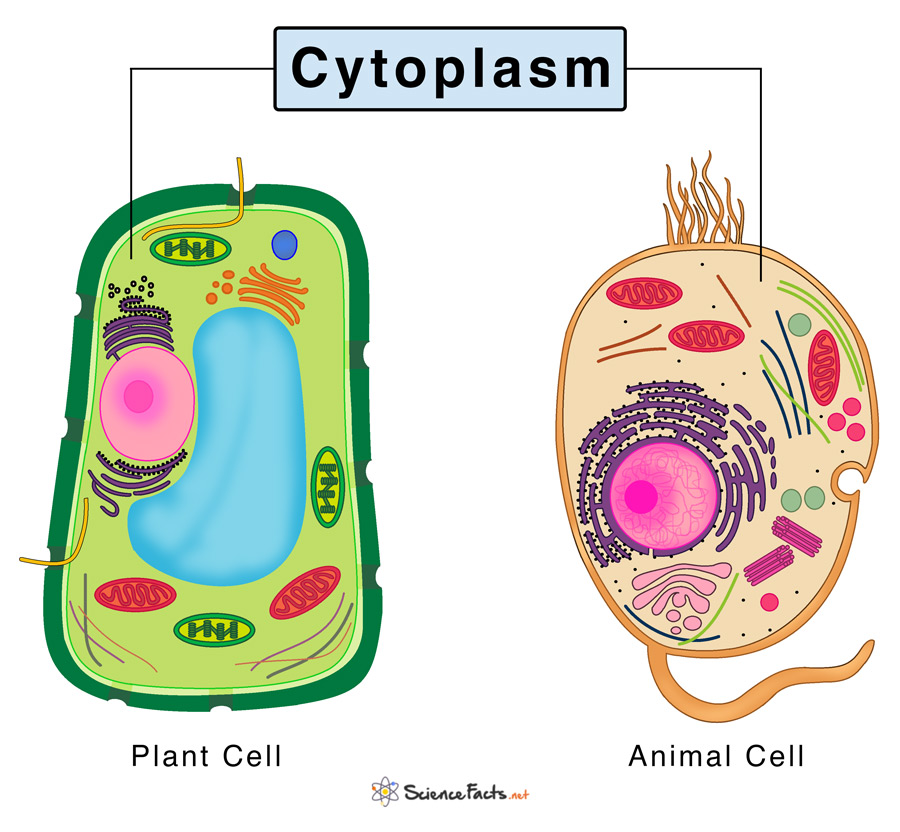Cytoplasm: Structure, Composition, and Functions
What is Cytoplasm
The cytoplasm is a semi-fluid substance that fills the entire space of a cell from the outer layer of the double membrane-bound nucleus to the inner layer ofthe cell membrane. In all eukaryotic cell types, such as plants and animals cells, it consists of the cytosol, the vesicles, the cytoskeleton, the inclusions, and all other organelles except the nucleus. In contrast, the cytoplasm of a prokaryotic cell, such as bacteria and archaea, is simply everything enclosed by the cell membrane and consists of the cytosol and all other cellular components.
Structure: What is Cytoplasm Made Of
The physical nature of cytoplasm is variable depending upon the physiological state of the cell. It is analogous to the jelly inside a donut. Underamicroscope, it is seen as a complex and crowded system containing a wide range of particles – from ions and small molecules to proteins as well as giant multi-protein complexes and organelles. Sometimes, excessive diffusion of small substances inside the cell that remains suspended in the cytoplasm makes it looks like a colloidal solution. At other times it appears to take on the properties of a gel-like or glass-like substance. The cytoplasm deforms slowly under external force being capable of regaining its original shape.
Layers
It is divided into two layers: a) ectoplasm – found below the cell membrane and made of the outer clear and glassy layer, consisting of a thick and jelly-like substance known as the plasmogel; b) endoplasm – found below the ectoplasm as the inner granular mass, consisting of a thin and liquefied fluid called the plasmosol with suspended cell organelles.
Parts
The three major componentsof the cytoplasm of a eukaryotic cell are described below:
- Cytosol: Also known as cytoplasmic matrix, it is gelatinous fluid, where other components of the cytoplasm remain suspended. The cytosol mainly consists of cytoskeleton filaments, organic molecules, salt, and water. It is that part of the cytoplasm that is not occupied by any organelle and is the site of multiple cellular processes such as growth metabolism, and cell division.
- Cell Organelles: Membrane-bound organs that remain suspended in the cytosol and perform specific functions necessary for cell survival. Some of the examples of organelles include mitochondria, ribosomes, nucleus, lysosomes, chloroplasts, endoplasmic reticulum, Golgi apparatus, and the cytoskeleton.
- Inclusion Bodies: Consist of insoluble, membrane-less particles or molecules that remain suspended in the cytosol. They are basically granules of starch and glycogen that can store energy. A vast range of inclusions are present in different cell types that range from calcium oxalate crystals or silicon dioxide crystals in plants to storage granules made of starch and glycogen, collectively known as cytoplasmic granules.
Properties
- Colorless jellylike fluid with 70%-80% water content
- Contains dissolved nutrients such as proteins, carbohydrates, salts, sugars, amino acids, nucleotides, and waste products
- Have a pH range between 7.0 -7.4
- The exact physical nature and chemical composition varies based on the metabolic and physiological state of the cell
- Conducts electricity due to its dissolved salt and mineral contents
Functions: What Does the Cell Membrane Do
Main Roles
- Acting as the site of many enzymatic reactions, and metabolic activities of the cell. Cellular respiration begins in the cytoplasm, whose products help mitochondria generate ATP, the cell’s energy currency. The cytoplasm is also the site of protein synthesis and is important for cell division.
- Acting as a buffer that protects the genetic material and organelles of the cell from damage due to an external shock.
- Maintaining proper osmotic pressure of the cell, thus helping in maintaining a stable internal environment (homeostasis).
Other Important Functions
- Helping in cell growth and expansion.
- Providing a medium for all the cell organelles to remain suspended.
- Creating an order within the cell for each organelle, providing each of them with specific locations through the movement of cytoplasm (cytoplasmic streaming). For example, in plants, the chloroplast’s location is close to the cell membrane to optimize photosynthesis. In both plant and animal cells, the positioning of the endoplasmic reticulum and Golgi apparatus with respect to the nucleus and cell membrane helps in the transport of proteins outside the cell.
- Distributing nutrients through the entire cell.
- Containing the subunits necessary for the formation of cell cytoskeleton that helps in maintain the cell’s shape and motility.
- Playing host to two organelles that contain their own genomes – the chloroplast and mitochondria. These help in the transfer of genetic material outside the nucleus directly from mother to the offspring (cytoplasmic inheritance).
FAQs
Ans. The cytoplasm of a cell was discovered by Robert Brown and other scientists in the year 1835. However, it was in 1863 that the term ‘Cytoplasm’ was coined by a Swiss biologist, Rudolf von Kölliker, as a synonym to protoplasm.
Ans. The physical process involving the division of cytoplasm of a parental cell into two daughter cells is called cytokinesis.
Ans. Division of cytoplasm, also known as cytokinesis occurs in the late telophase stage of cell division.
Ans. Ribosomes are the organelles responsible for synthesizing proteins that are further modified in the rough endoplasmic reticulum and the Golgi apparatus to be used in the cytoplasm.
Ans. Cytoplasm involves all the contents inside the cell membrane of a cell excluding the nucleus whereas protoplasm includes cytoplasm, along with the nucleus of the cell.
-
References
Article was last reviewed on Thursday, June 24, 2021




